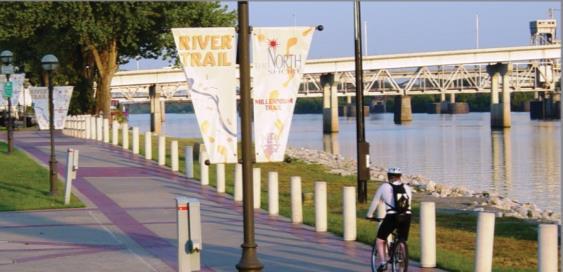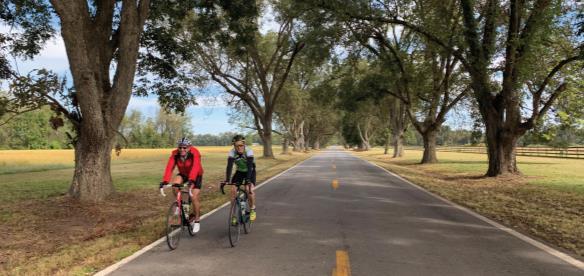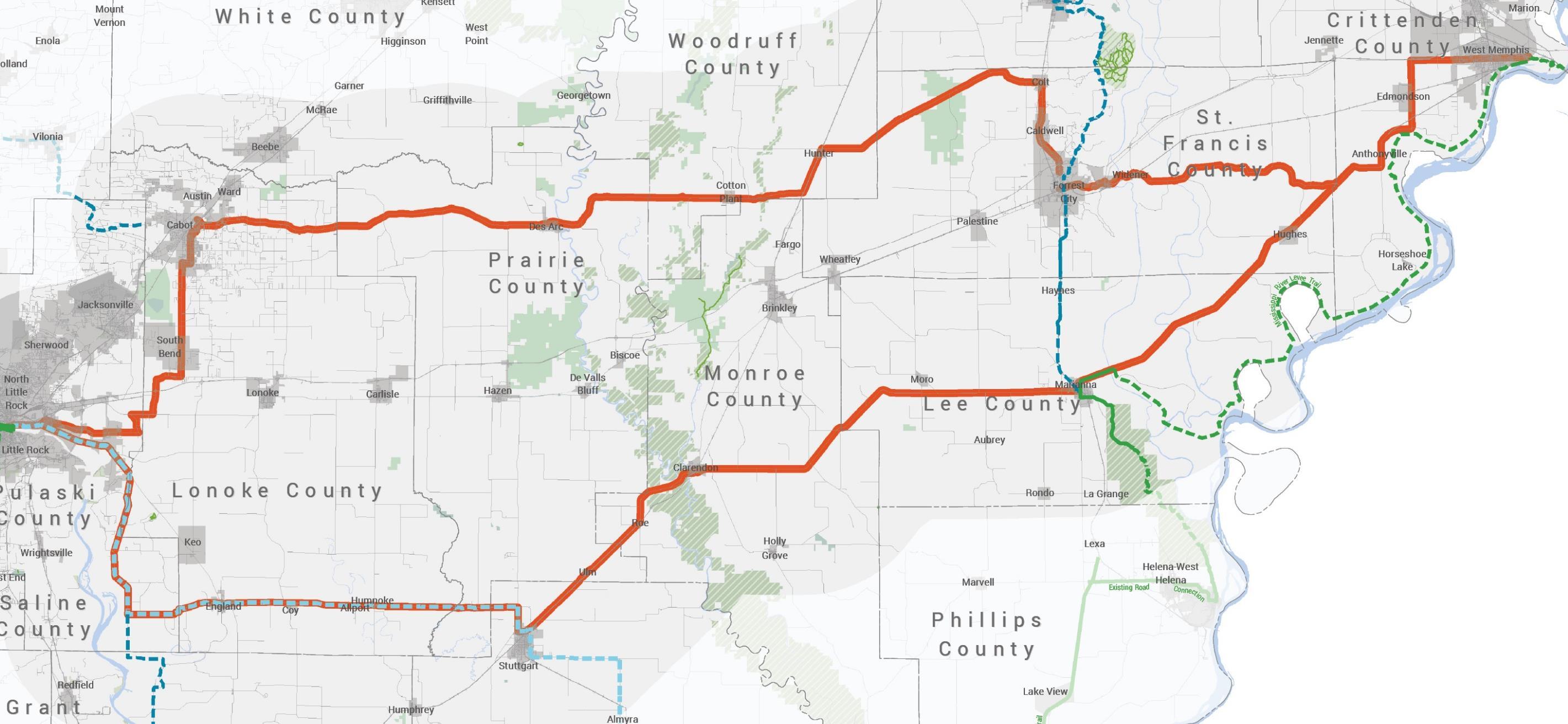
4 minute read
CraftonTull
VALUE TO CLIENT, PUBLIC & OTHER DESIGNERS
Few regionally significant planning projects are conducted, vetted, and see implementation shortly after completion. Even fewer address both urban and rural challenges that directly improve the quality of life for residents and tourists through grant funding that spurs change in not only in the built environment-, but also communities’ way of thinking.
Advertisement
The U.S. Bicycle Route System (USBRS) is a developing national network of bicycle routes connecting urban and rural communities via signed roads and trails, according to Adventure Cycling, the organization that has aided in the growth of USBRS. The system will eventually encompass 50,000 miles of routes and open new opportunities for cross-country and regional touring, as well as commuting by bike. This system benefits communities by providing new bicycle routes, enhancing safety, and increasing tourism and economic activity. The USBR feasibility study in central and eastern Arkansas was conducted to determine the safest and most interesting route for cycling tourism from North Little Rock to West Mem-phis, which is a crucial piece of USBR 80.
“ThedesignationofUSBR80fromNorthLittleRocktotheTennesseestatelineisthefirstUSBRdesignation in Arkansas and the firstsegment of USBR 80designated in the country.” Rex Vines, ArDOTDeputy DirectorandChiefEngineerandmemberoftheSpecialCommitteeonU.S. RouteNumbering.
QUALITY OF ANALYSIS & PLANNING EFFORT
Two potential routes were identified in the Arkansas Bicycle and Pedestrian Transportation Plan that was adopted by Ar-DOT in 2017. The USBR80 feasibility study scope included:
• Data collection and base mapping
• Development of route criteria
• Identification of stakeholders
• Development of fieldwork and scoring forms
• On-site verification of routes
• Community Assessments
• Route evaluations and comparisons
• Field verification of select route
• Compiled final report
Both the northern and southern route options were each approximately 160-plus miles. To understand which of the two routes to select, criteria for roadway characteristics and character of the communities along the route needed to be analyzed. Roadway quantitative factors were assessed, such as aver-age daily travel on each route, posted travel speed, shoulder, land and bridge width, topography, connectivity to other routes. Qualitative factors were analyzed during fieldwork, such as pavement condition, truck volume, visibility/safety, roadway lighting and view, as well as sheds and vistas. Community character quantitative factors were assessed such as lodging and camping, food and convenience, -cellular service, distance between communities, urgent care and walk-in clinic locations, and county health rankings. Qualitative factors were analyzed during fieldwork , such as variation of landscape, availability of shade, as well as historical and cultural points of interests near the routes. An online survey for input from the cycling community in Arkansas as well as identified stakeholders was conducted to verify the analysis findings before the route selection was finalized. Once the criteria scoring was tabulated, the 165-milesouthern route was chose.
Relationship To Context
The steering committee worked on implementing the HUB community guidelines, introduced in the statewide bicycle and pedestrian plan, which rates each town’s amenities available to support cycling tourists using a numeric scale. During the analysis phase of the study, on-site fieldwork helped verify and analyze communities on the USBR 80 route assessing these essential amenities. The goal is to house the HUB community matrix on the Arkansas State Parks website to allow riders traversing the state to plan their stops by each town’s1-4 diamonds rating (Arkansas is known for unique access to diamond mining).Communities, may over time, strive to add or upgrade amenities to improve their diamond rating. These upgrades will not only benefit the tourists but have already made direct benefits to the town’s residents.
Relationship To Context
The steering committee worked on implementing the HUB community guidelines, introduced in the statewide bicycle and pedestrian plan, which rates each town’s amenities available to support cycling tourists using a numeric scale. During the analysis phase of the study, on-site fieldwork helped verify and analyze communities on the USBR 80 route assessing these essential amenities. The goal is to house the HUB community matrix on the Arkansas State Parks website to allow riders traversing the state to plan their stops by each town’s1-4 diamonds rating (Arkansas is known for unique access to diamond mining).Communities, may over time, strive to add or upgrade amenities to improve their diamond rating. These upgrades will not only benefit the tourists but have already made direct benefits to the town’s residents.
ENVIRONMENTAL SENSITIVITY & SUSTAINABILITY
Health and physical activity has continued to be the focus in the small rural towns along the USBR 80 route since engaging with each town’s leadership during the study. After introducing the need for safe active mobility, access to healthy foods, and availability to urgent healthcare, many of these town have made marked progress to their mobility network through citywide master plans. Additionally, the quality of their downtowns has been improved through grantfunded open space projects. These improvements have connected the community in ways previously unimagined. ArDOT was alerted to the poor condition of a key bridge discovered during the fieldwork that resulted in moving its replacement up to an immediate phase and added bicycle and pedestrian accommodations. Sustainability for many residents in rural communities can be a foreign concept when not related to agriculture. By showing how the economic health of the town as well as physical health of the residents can be im-proved through upgrades to accommodate a different type of tourists, the importance is soon understood. This also makes the community more sustainable in its ability to maintain and support this improved quality of life over time.
Likelihood Of Successful Implementation
The USBR 80 feasibility study, adopted by ARDOT in November 2022, became Arkansas’ first nationally recognized bicycle route and the first segment of the USBR 80 route that will one day stretch from the coast of North Carolina to Oklahoma City. "Thisroundofdesignationsmarksexcitingprogressforthisproject. I’mparticularlyexcitedtoseethe first-timedesignation forArkansas, a state I called home formany years.” Jennifer O’Dell, Executive Director of Adventure Cycling This regional feasibility study was a great example of how multiple state agencies working together can have an impact on small Arkansas towns. The partner agencies that collaborate as a steering committee included University of Arkansas Medical Science (grant recipient for study), Arkansas Department of Transportation, Arkansas Department of Heritage Parks and Tourism, and Arkansas Economic Development Commission. Each town and county along the route was required to pass a city resolution to officially acknowledge support of the route. ArDOT reviewed and approved the feasibility study route se-lection then submitted it to Adventure Cycling for approval. That approval was ultimately granted in November 2022.












